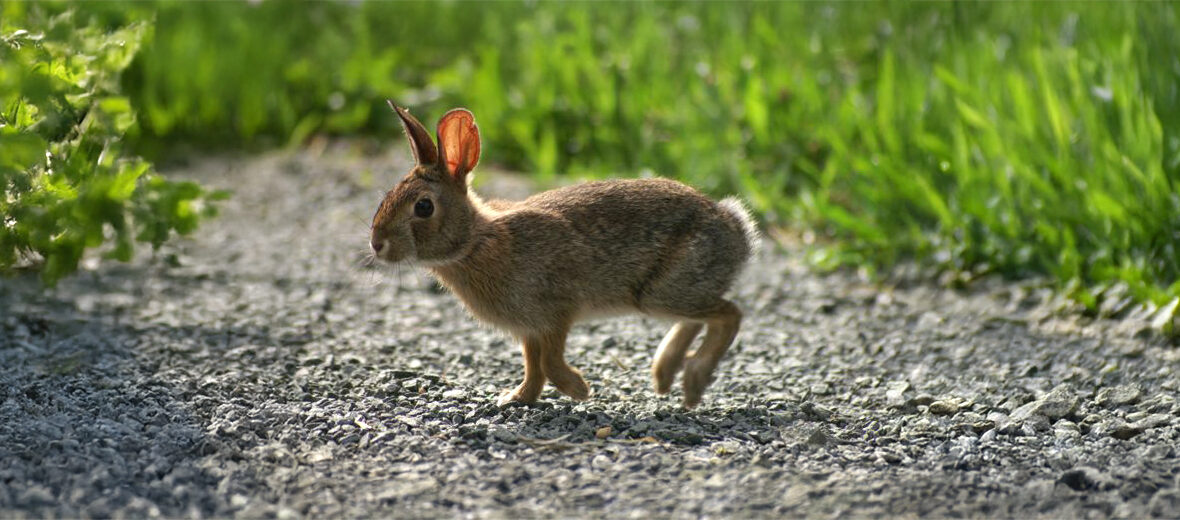
The New England cottontail, aka cooney, gray rabbit, brush rabbit, wood hare, or wood rabbit, looks very similar to the eastern cottontail. This species of rabbit has had its populations reduced by 86% since 1960. They unfortunately face the threats of habitat loss and destruction at the hands of residential & commercial developments, and logging; the construction of utility lines, which can uproot these lagomorphs from the safety of their burrows; recreational activities; hunting; trapping; invasive species, which can introduce disease, competition for food, predation, and could thin out their bloodlines; and climate change, that can cause habitat shifting and alteration. These cottontails are listed as Vulnerable by the IUCN.
First the Stats…
Scientific name: Sylvilagus transitionalis
Weight: Up to 2.9+ lbs.
Length: Up to 17.3 inches
Lifespan: Up to 3+ years
Now on to the Facts!
1.) They numbered an estimated 17,000 wild individuals, as of 2018.
2.) Due to their sharp decrease in numbers, they are a candidate for protection under the Endangered Species Act.
3.) Hunting has been restricted in some locations where both the eastern and New England cottontail species coexist, in order to protect the remaining New England cottontail populations.
4.) These cottontails need at least 12 acres to maintain a stable population. In New Hampshire, the number of suitable patches dropped from 20 – 8 in the early 2000s. The ideal habitat is 25 acres of continuous early successional habitat within a larger landscape that provides shrub wetlands and dense vegetation.
5.) In the past, federal funding has been utilized for habitat restoration work on state property, including the planting of shrubs and other growth that is critical to the rabbit’s habitat. But that funding is likely to be halted.
But wait, there’s more on the New England cottontail!
6.) New England cottontails and eastern cottontails are so identical in appearance that the only reliable way to tell them apart is via genetic testing of tissue, through fecal samples (rabbit poop), or by an examination of their skulls, which shows key morphological distinctions.
7.) The other way to tell them apart is that the New England cottontail also usually has black fur between and on the anterior surface of their ears, which the Eastern cottontail is missing.
Did you know…?
Cottontails are sexually dimorphic in that females are larger than males.
8.) They can be found in New England, New York, Connecticut, Rhode Island, Massachusetts, New Hampshire, and into southern Maine.
9.) At 1 point, they also inhabited Quebec, Canada. But they have been extirpated from Canada for a while now.
10.) Due to the introduction of more than 200,000 eastern cottontails in the early 20th century, mostly by hunting clubs, the New England cottontail’s numbers have sharply declined because the eastern cottontails have a better ability to avoid predators.
But wait, there’s still more on the New England cottontail!
11.) Introduction of invasive plant species like multiflora rose, honeysuckle bush, and autumn olive in the 20th century might have also displaced many native species that these cottontails rely upon for food.
12.) The increase of white-tailed deer populations have also played a part in the reduction of these cottontails, as they eat some of the same folliage and trample the understory these critters depend on.
Did you know…?
Due to their habitat having less vegetative cover, they are forced to forage out in the open more often. This subjects them to a greater chance of predation.
13.) In 2011, researchers from the University of Rhode Island reported in a survey that the New England cottontail was on the verge of extirpation from Rhode Island as well, because of competition from eastern cottontails, habitat loss, and an increase in predator populations.
14.) These cottontails prefer early successional forests — young forests (typically less than 25 years old) with a thick understory of dense, tangled vegetation, aka scrubland or brushland, preferably consisting of blueberry or mountain laurel.
15.) New England cottontails rarely venture more than 16+ feet from the safety of cover.
But wait, there’s still a little more on the New England cottontail!
16.) These critters are preyed on by weasels, cats, dogs, red foxes, fishers, birds of prey, coyotes, bobcats, grey wolves, lynx, and wolverines.
17.) Breeding takes place between 2 – 3 times a year.
Did you know…?
Only a mere 15% of newborns survive to their 1st year!
18.) Females undergo up to a 28 day gestation (pregnancy) that yields up to 8 kittens.
19.) Leaves, stems, wood, bark, flowers, fruits, and seeds from various grasses and forbs make up their diet.
20.) In 2013, the State of Connecticut began a habitat restoration project in Litchfield County, clearing 57 acres of mature woods in order to create a meadowland and second-growth forest habitat much needed by these rabbits.
21.) New England cottontails are crepuscular (active at dawn and dusk).
Now a Short New England Cottontail Video!
Be sure to share & comment below! Also, check out the Critter Science YouTube channel. Videos added regularly!
Want to suggest a critter for me to write about? Let me know here.
Some source material acquired from: Wikipedia & IUCN
Photo credit: Silly rabbit




